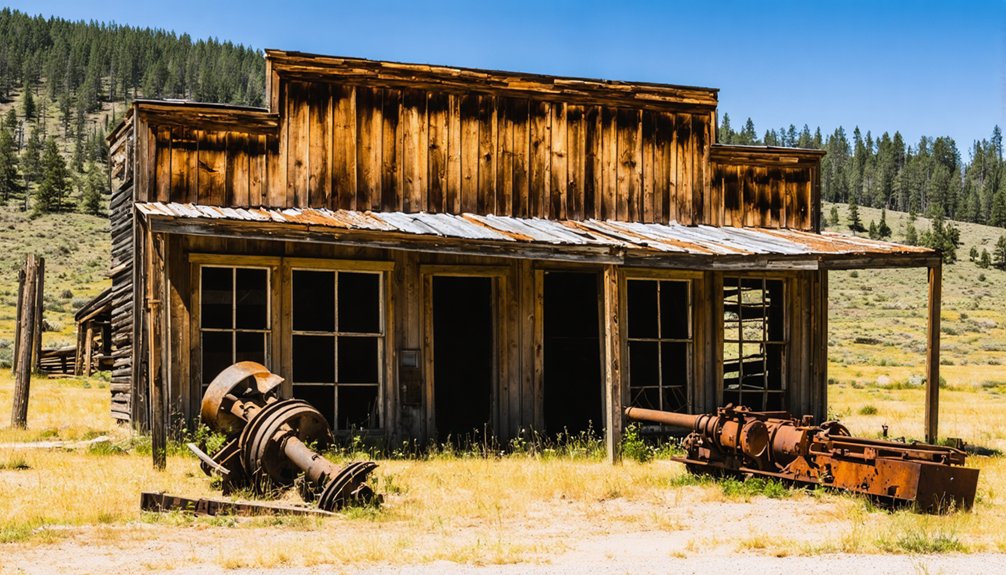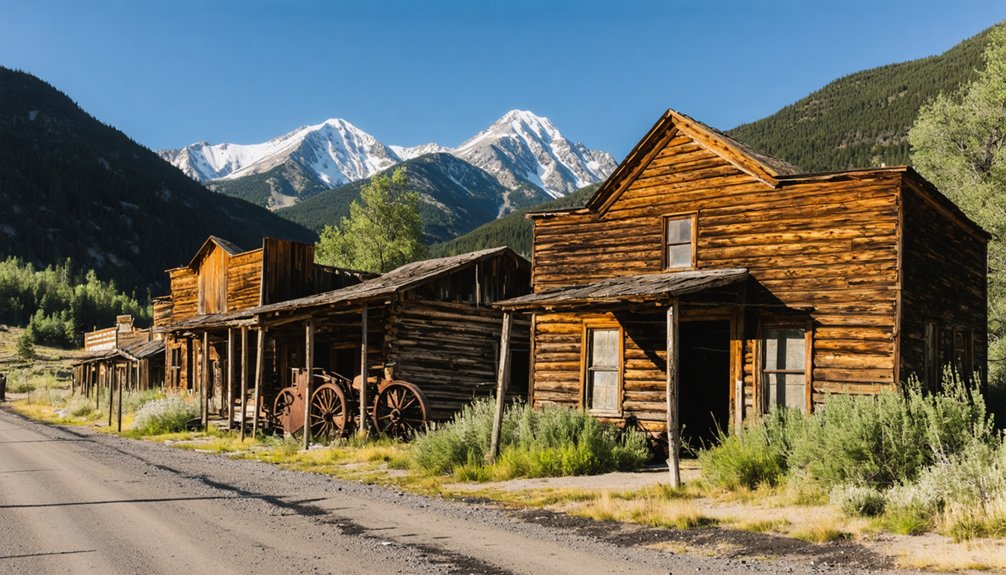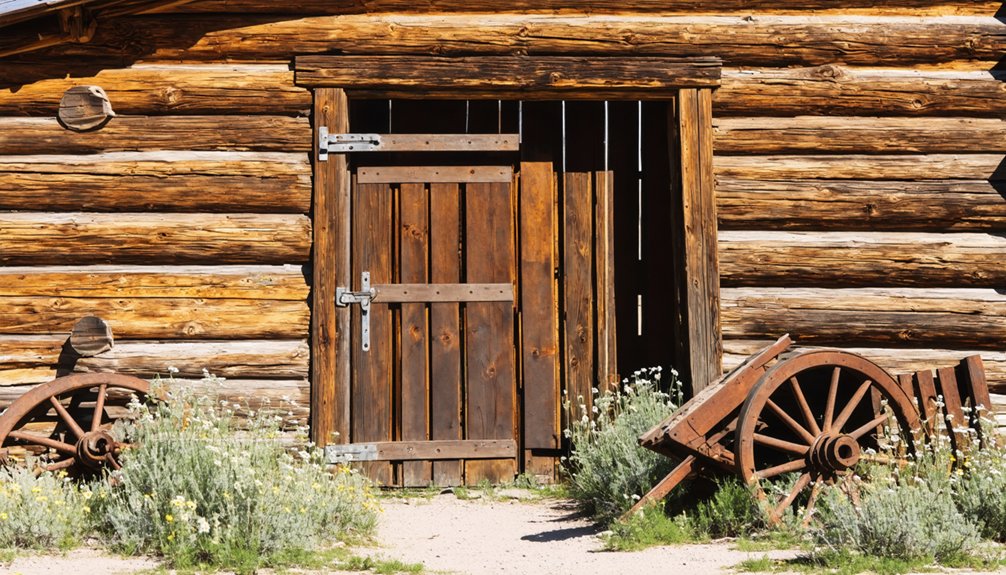You’ll find the ghost town of Caribou City tucked away in southeastern Idaho’s Caribou Mountains, where gold was discovered in 1863. During its peak, this bustling mining settlement supported 1,500 residents, including 700 Chinese miners, with saloons, gambling halls, and supply stores dotting the mountainside. By 1930, dwindling gold production had emptied the town, leaving only weathered cabins, rusted mining equipment, and hidden tales of frontier dreams scattered across the alpine landscape.
Key Takeaways
- Caribou City was a thriving Idaho gold rush town established in 1863, reaching a peak population of 1,500 residents including 700 Chinese miners.
- The town generated $1.67 million in gold production by 1900 and featured saloons, gambling halls, hotels, and various entertainment venues.
- Economic decline began as gold resources diminished, leading to complete abandonment by 1930 when the last resident moved to Swan Valley.
- Today, only weathered cabin remnants, crumbling foundations, and scattered mining equipment remain as evidence of the former boomtown.
- Located in the Caribou Mountains of southeastern Idaho, the ghost town site contains deteriorating stamp mills and mine tunnels.
The Discovery of Gold and Early Settlement
When Thomas Groves and his prospecting party discovered gold near Idaho’s Caribou Mountains in 1863, they sparked a transformative chapter in southeastern Idaho’s history. The initial placer gold findings, though modest, quickly drew early miners from California, Montana, and surrounding territories, igniting a regional gold rush.
You’ll find Caribou City’s origins rooted in the swift response to these discoveries. What began as a simple collection of tents and log cabins rapidly evolved into a bustling mining settlement.
Life During the Mining Boom Years
During Caribou City’s peak mining years, you’d have found a rugged community where life revolved around the demanding pursuit of gold. You’d have lived in basic log cabins, drawing water from springs and wells, while dealing with primitive sanitation that tested everyone’s resilience.
Life in Caribou City meant rustic cabins and daily hardships, as pioneers chased golden dreams in unforgiving mountain terrain.
The harsh conditions didn’t stop a vibrant community from emerging. You’d have rubbed shoulders with miners working 12-hour days, merchants running general stores, and families trying to carve out a life in the mountains.
While men dominated the population, women ran boarding houses and maintained domestic life. The saloons and gambling halls served as your social hubs, while churches and occasional celebrations strengthened community bonds.
Despite the constant dangers of mine accidents and limited medical care, the town’s diverse residents, including Irish and German immigrants, forged ahead with determination.
Mining Operations and Economic Growth
As gold discoveries sparked excitement across Caribou Mountain in the early 1870s, you’d have witnessed an explosion of mining activity that transformed the rugged landscape. The area’s original prosperity began when Carriboo Jack’s diggings first revealed the precious metal in 1869.
Mining technologies advanced rapidly, with hydraulic monitors blasting through creek beds and ball mills crushing ore at operations like the Evergreen mine. You’d have seen ambitious tunneling projects, including the impressive 1,600-foot passage at the Searchlight mine. Miners employed hydraulic giants that used high-pressure water to extract gold more efficiently.
The economic fluctuations brought staggering wealth to some, with reported gold deposits reaching $1.67 million by 1900.
Caribou City flourished as a bustling hub of 1,500 residents, complete with stagecoach service and a diverse population that included 700 Chinese miners. The town’s saloons and gambling dens thrived, while supply stores and essential services supported the growing community.
Daily Life in a Mountain Mining Town
You’d find a stark contrast between the grueling 12-hour workdays in Caribou City’s mines and the vibrant social gatherings that brought the community together in dance halls and seasonal celebrations.
In the harsh mountain environment, you’d need to master essential survival skills like preserving food in snow banks and maintaining heat with scavenged wood in poorly insulated cabins. Residents learned to prepare earlier each year for winter, stockpiling firewood and supplies based on previous harsh experiences. Children often gathered at sandy mine dumps to play after their school day ended.
While miners earned as little as $1.00 per hour, they created a rich social fabric through shared meals, organized clubs, and community-supported activities like competitive wood skiing.
Mining Community Social Life
Life in Caribou City hummed with the energy of a typical mountain boomtown, where 1,500 residents created a vibrant social scene centered around saloons, gambling halls, and dance halls.
You’d find a remarkable spirit of cultural exchange between Chinese and white miners, who worked and socialized together with less discrimination than other mining camps of the era. The town’s 32 whorehouses fueled much of the nightlife entertainment and social activity. The miners spent their days searching for placer gold deposits at the high elevation of 9,383 feet.
- Dancing girls entertained at local saloons, drawing miners after long days of placer mining.
- Community gatherings brought together the town’s diverse population of 700 Chinese and white residents.
- Outdoor recreation like hunting and fishing offered respite from mining life.
- Gambling halls buzzed with activity, attracting both locals and visitors.
- Traditional celebrations from different cultures enriched the town’s social fabric.
Mountain Living Survival Skills
Living in Caribou City demanded a robust set of survival skills to endure the harsh mountain environment year-round.
You’d need to master shelter maintenance, constructing sturdy cabins from wood and brush while sealing gaps with mud or moss to keep winter winds at bay. Fire safety was paramount – you’d gather and store dry hardwoods during summer, maintain clear fire rings, and carefully manage smoke signals that might attract unwanted attention. Having cotton ball fire starters hidden in your cabin was essential for emergency warmth during harsh winters.
Creative solutions for housing were vital, as many residents resorted to alternative dwellings to survive the challenging conditions.
Daily survival meant boiling water from mountain streams, preserving food through smoking and salting, and keeping a constant supply of firewood.
You’d layer up in wool and leather, mend your own clothes, and maintain essential tools. With limited resources, you’d need to know which local plants were edible and how to effectively preserve game meat through the seasons.
Work and Leisure Balance
While miners labored intensely during the short summer mining season, Caribou City’s social scene thrived year-round through its 32 whorehouses, gambling halls, and bustling saloons.
You’d find a unique work life balance where hard physical labor in placer mining during daylight hours gave way to vibrant nightlife and entertainment in the evening.
The social dynamics of this mountain town offered diverse leisure options:
- The three-story “Green House” hotel provided upscale lodging rare for mining camps
- Stage coaches brought fresh faces and supplies, keeping social connections alive
- Dancing girls performed nightly in saloons after miners finished their shifts
- Boarding houses served as community hubs where miners could gather for meals
- Gambling halls offered chances to strike it rich without wielding a pick and shovel
The Decline of a Frontier Dream
Despite its meteoric rise as a booming frontier settlement, Caribou City‘s fate echoed the tragic pattern of countless western mining towns.
You’ll find a story of economic dependency that proved fatal – when gold production waned, the town’s very lifeline was severed. With no industry beyond mining to sustain it, the transient population quickly abandoned their dreams of frontier fortune. The town had generated an impressive $1.6 million in gold during its peak years.
Much like the devastating fire of 1905 that destroyed Caribou, Colorado, catastrophic events could spell doom for these vulnerable frontier settlements.
The harsh reality of Caribou City’s isolation worked against its survival.
You’d have faced brutal winters, primitive infrastructure, and challenging access routes that discouraged permanent settlement. By 1930, even the last resident, a 96-year-old holdout, finally surrendered to reality and moved to Swan Valley.
Today, the town stands empty – a symbol of the fragile nature of single-resource economies in the American West.
What Remains Today: A Journey Through Time

As you venture into Caribou City today, you’ll find weathered cabin remnants and foundations dotting the remote mountainside, serving as silent sentinels to the area’s golden past.
Old mining tools and machinery still lie scattered across the surrounding hills, offering tangible connections to the site’s mineral-rich history.
Nature has steadily reclaimed much of the former boomtown, with forest and elements slowly eroding what was once a bustling community of 1,500 residents.
Crumbling Cabins Stand Watch
The crumbling foundations and weathered logs of Caribou City tell a stark tale of abandonment and decay.
You’ll find remnants of a once-thriving ghost town where 2,000 souls carved out their dreams in rough-hewn cabin architecture.
Nature’s relentless march has reclaimed these pioneer dwellings, leaving only scattered traces for modern explorers to discover.
- Log walls have collapsed into jumbled heaps, with roofs and floors long since vanished.
- Forest undergrowth masks the original street layout, requiring keen eyes to spot foundations.
- Seasonal freeze-thaw cycles continue to break down the remaining structural elements.
- Talus slopes and erosion slowly bury what’s left of the stone foundations.
- Remote access has preserved these ruins from extensive looting, though time takes its toll.
Mining Equipment Still Visible
Rusted mining equipment dots the mountainous landscape of Caribou City, offering silent testimony to its gold-mining heyday.
You’ll find remnants of both placer and lode mining operations scattered across the hillsides, including abandoned adits, shafts, and prospect pits. These industrial artifacts hold immense historical significance, revealing the scale of operations that once supported over 1,500 residents.
While weathered by time, the equipment remains a compelling tourist attraction.
You’ll need a 4-wheel drive or ATV to access the site, where you can explore deteriorating stamp mills, transport carts, and various mining tools.
Though no formal preservation efforts exist, these relics continue to draw history enthusiasts during the summer months.
Each piece of equipment tells a story of the challenging conditions miners faced in their pursuit of gold.
Remote Wilderness Takes Over
Nature has steadily reclaimed the once-bustling streets of Caribou City, transforming the former gold mining settlement into a remote wilderness landscape. The natural reclamation is evident as you explore the site, where trees and thick underbrush now dominate areas that once housed 2,000 residents.
Wildlife presence has returned in force, making the ghost town their home among scattered ruins and mining remnants.
- Only a few collapsed log structures remain visible through the dense vegetation
- Rusted pipes and talus piles blend seamlessly into the natural environment
- Mining claim signs persist, indicating ongoing small-scale operations nearby
- The original street layout has vanished beneath years of forest growth
- Challenging 4WD access keeps the site’s remote character intact
Legacy of a Lost Mining Community

While many mining boomtowns faded into obscurity, Caribou City’s legacy endures as a tribute to Idaho’s ambitious gold rush era.
You’ll find its cultural heritage reflected in the remarkable $1.67 million gold production that transformed this remote mountain settlement into a thriving hub of 1,500 residents.
The town’s historical significance extends beyond mere mineral wealth – it was a melting pot where 700 Chinese miners worked alongside others, creating a diverse community that flourished with hotels, saloons, and entertainment venues.
Caribou City’s vibrant cultural tapestry wove together Chinese laborers and diverse settlers, fostering a community rich in entertainment and commerce.
Though the last resident departed in the 1930s, Caribou City’s story lives on through its scattered ruins and the extensive network of tunnels carved into Caribou Mountain, reminding you of an era when fortune seekers shaped the American West.
Frequently Asked Questions
Are There Any Reported Ghost Sightings or Paranormal Activity in Caribou City?
Ever wonder about ghost experiences in this old mining town? You won’t find documented paranormal investigations or ghost sightings here – despite its “ghost town” status, there’s no evidence of supernatural activity.
What Dangerous Wildlife Encounters Were Documented During the Town’s Active Years?
You’ll find limited records of wildlife encounters during Caribou City’s heyday, except for Caribou Jack’s deadly grizzly bear incident. Miners faced more immediate dangers from mining hazards than wild animals.
How Did Children Receive Education in Such a Remote Mining Settlement?
With 8,000 residents at its peak, you’d find mining families sending their children to a one-room brick schoolhouse, where they’d learn basic subjects despite remote schooling challenges and irregular attendance patterns.
Were There Any Notable Crimes or Lawless Incidents in Caribou City?
You won’t find detailed crime statistics or major recorded incidents, though saloon brawls and gambling disputes were common. With minimal law enforcement, the town likely experienced typical mining camp lawlessness and disorder.
What Indigenous Tribes Inhabited the Area Before the Mining Settlement Began?
While you might assume it was uninhabited wilderness, the Shoshone and Bannock tribes had thrived there for thousands of years, following seasonal patterns between the Snake River valleys and mountain territories.
References
- https://yellowpinetimes.wordpress.com/2019/11/10/idaho-history-nov-10-2019/
- https://history.idaho.gov/wp-content/uploads/0205.pdf
- https://www.idahogeology.org/Uploads/Data/USBM-Publications/MLA_15-93.pdf
- https://www.hmdb.org/m.asp?m=106213
- https://westernmininghistory.com/mine-detail/10289993/
- https://www.ghosttowns.com/states/id/cariboucity.html
- https://www.idahogeology.org/pub/Pamphlets/P-131.pdf
- https://www2.zukiworld.com/feature_cariboumountain/
- https://www.themtnear.com/stories/caribou-and-cross-mines-part-of-nederlands-history-for-152-years
- https://parkcityhistory.org/growing-up-in-a-mining-town/



